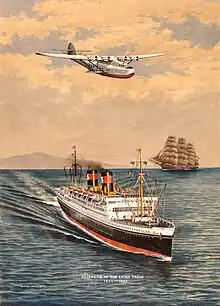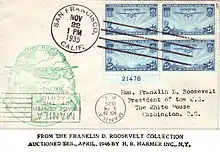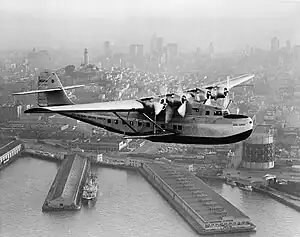| M-130 | |
|---|---|
.jpg.webp) | |
| China Clipper in 1935 | |
| Role | Flying Boat |
| Manufacturer | Glenn L. Martin Company |
| First flight | December 30, 1934 |
| Introduction | November 22, 1935 |
| Status | Destroyed |
| Primary user | Pan American Airways |
| Number built | 3 |

The Martin M-130 was a commercial flying boat designed and built in 1935 by the Glenn L. Martin Company in Baltimore, Maryland, for Pan American Airways. Three were built: the China Clipper, the Philippine Clipper and the Hawaii Clipper. All three had crashed by 1945. A similar flying boat design called the Martin 156) and named Russian Clipper, was built for the Soviet Union; it had a larger wing (giving it greater range) and twin vertical stabilizers.
Martin named them the Martin Ocean Transports, but to the public they were the "China Clippers", a name that became a generic term for Pan Am's large flying boats - including, retroactively, the smaller Sikorsky S-42 (first flown in 1931) and larger Boeing 314 (first flown in 1938).[1]
All three were eventually lost; the first in 1938 disappeared on flight over the Pacific, then in 1943 one flew into a California mountainside in poor weather, and finally in 1945 the last broke up on landing in Trinidad and Tobago. In their time, they blazed some of the longest airline routes yet and also served in WW2 as transports. One helped evacuate about 40 civilians from the ill-fated Wake island at the start of WW2, which was soon invaded by the Empire of Japan.
Operational history

.jpg.webp)

Designed to meet Pan American World Airways President Juan Trippe's desire for a trans-Pacific aircraft,[2] the M-130 was an all-metal flying boat with streamlined aerodynamics and engines powerful enough to meet Pan Am's specified range and payload. They were sold at US$417,000. The first flight was on December 30, 1934.[3] On November 22, 1935, the China Clipper, piloted by Captain Edwin C. Musick and First Officer R.O.D. Sullivan, flew the first trans-Pacific airmail route.[1] A postage stamp, Scott Catalog C-20, was printed for use on the transpacific service. With extended service, two more denominations were later issued. All three have the same design, showing the M-130 in flight.
Weekly passenger flights across the Pacific Ocean began in October 1936 when Hawaii Clipper left San Francisco for Manila, stopping overnight at Honolulu, Midway Island, Wake Island and Guam. An S-42 began flying the Manila-Hong Kong route in 1937, and the Martins replaced it in 1938.[1]
In July 1938, Hawaii Clipper disappeared between Guam and Manila with the loss of nine crew and six passengers. No cause was determined.[4]
Their range and capacity made them valuable for trans-ocean military flights during World War II. Beginning in 1942, the two remaining planes were pressed into transport roles for the United States Navy.
The Philippine Clipper was on a civilian flight when it encountered – and survived – the surprise Japanese attack on Wake Island in December 1941, following the attack on Pearl Harbor.[5][6] It crashed in January 1943, between Ukiah and Boonville, California on a flight from Honolulu. ComSubPac Admiral Robert H. English and 18 others were killed.[7]
In January 1945, the China Clipper left Miami on Pan Am's first scheduled flight to what is now Kinshasa in the Democratic Republic of the Congo. The route went via Brazil before crossing the South Atlantic Ocean, but the last surviving M-130 did not complete the flight. It broke up and sank during landing at Port of Spain, in the West Indies islands of the British colonies of Trinidad and Tobago on January 8, killing 23 of those on board.[8]
| Name | Image | Registration | Delivered | Lost |
|---|---|---|---|---|
| Hawaii Clipper | .jpg.webp) |
NC14714 | March 3, 1936 | July 28, 1938 [10][11] |
| Philippine Clipper | .jpg.webp) |
NC14715 | November 14, 1935 | January 21, 1943 |
| China Clipper | .jpg.webp) |
NC14716 | October 9, 1935 | January 8, 1945[12] |
Specifications (Martin M-130)
Data from
General characteristics
- Crew: six-nine (Captain, First Officer, Junior Flight Officer, Engineering Officer, Assistant Engineering Officer, Radio Operator, Navigation Officer, plus cabin stewards)
- Capacity: 36 day, 18 night passengers
- Length: 90 ft 10.5 in (27.7 m)
- Wingspan: 130 ft 0 in (39.7 m)
- Height: 24 ft 7 in (7.5 m)
- Max takeoff weight: 52,252 lb (23,701 kg)
- Powerplant: 4 × Pratt & Whitney R-1830-S2A5G Twin Wasp 14-cylinder radial engines, 830 hp (708 kW) each later 950 hp with hydromatic propellers
Performance
- Maximum speed: 180 mph (290 km/h, 160 kn)
- Cruise speed: 130 mph (209 km/h, 110 kn)
- Range: 3,200 mi (5,150 km, 2,800 nmi)
- Service ceiling: 10,000 ft (3,048 m)
See also
Related development
Related lists
References
- 1 2 3 Flying Clippers Archived 2010-04-06 at the Wayback Machine undated, URL retrieved 19 August 2007
- ↑ Chasing the Sun at PBS.com undated, URL retrieved on 20 August 2007
- ↑ The Golden Age of Aviation undated, URL retrieved on 20 August 2007.
- ↑ Aviation Safety Network 10 October 2006, URL retrieved 19 August 2007
- ↑ Flying Clippers at War Archived 2010-09-11 at the Wayback Machine undated, URL retrieved on 20 August 2007
- ↑ "Japs Attacked Midway Island". Madera Tribune. December 11, 1941. Retrieved 23 March 2020.
- ↑ Aviation Safety Network undated, URL retrieved on 20 August 2007.
- ↑ Accident Report at Aviation Safety Network October 23, 2006, URL retrieved on August 20, 2007
- ↑ "Martin M-130". Pan Am Clipper Flying Boats. Retrieved 23 March 2020.
- ↑ "Manila Clipper Lost at Sea". Madera Tribune. July 29, 1938. Retrieved 23 March 2020.
- ↑ Raeburn, Paul (August 11, 1980). "Has 'flying boat,' been found?". Desert Sun. Associated Press. Retrieved 23 March 2020.
- ↑ "23 Killed in Clipper Crash in Trinidad". Santa Cruz Sentinel-News. UP. January 10, 1945. Retrieved 23 March 2020.
Bibliography
- Davies, Ed (May–June 2000). "Clipper to China: Pan Am's Martin 130s in the Pacific, Part Two". Air Enthusiast. No. 87. pp. 2–8. ISSN 0143-5450.
- "Specifications of American Airplanes". Aviation. Vol. 36, no. 4. April 1937. pp. 66–71.
External links
- Martin M-130 photo gallery at the University of Miami Library
- "China Clipper is Giant of Pacific Air Fleet" Popular Mechanics, January 1936